
December 3, 2001
|
 |
Wheat
 The cold temperatures that covered a large portion of District 7 (November 27-29) could prove damaging to the late planted wheat crop. Damage to wheat would have been worse if it weren't for the high soil moisture from rains received in early- and mid-November combined with snow. Snow is an excellent insulator and once it exceeds one inch of depth it provides the equivalent of about 10 degrees of protection. Wheat that is well tillered should be able to withstand temperatures in the -5 degree range for at least a short period of time. The longer it stays this cold the greater the risk of killing the growing point. If the top 2 inches of soil is wet, this will help insulate the wheat growing point. Expect to see significant leaf burn on most of our wheat.
The cold temperatures that covered a large portion of District 7 (November 27-29) could prove damaging to the late planted wheat crop. Damage to wheat would have been worse if it weren't for the high soil moisture from rains received in early- and mid-November combined with snow. Snow is an excellent insulator and once it exceeds one inch of depth it provides the equivalent of about 10 degrees of protection. Wheat that is well tillered should be able to withstand temperatures in the -5 degree range for at least a short period of time. The longer it stays this cold the greater the risk of killing the growing point. If the top 2 inches of soil is wet, this will help insulate the wheat growing point. Expect to see significant leaf burn on most of our wheat.
Producers that are planning on grazing wheat need to make sure the secondary root system has started to develop. The secondary root system serves as an anchor for the plant and keeps the cattle from pulling the plants out of the ground. If there is no secondary root system, then grazing should be postponed until a later date.
The age of the 2001-2002 wheat crop ranges from not being planted yet to three months old. It might be useful to review the Growth Stages of Wheat: Identification and Understanding Improve Crop Management written by Travis D. Miller, Professor and Extension Agronomist and the Kansas Wheat Production Handbook (PDF) C-529 revised May, 1997. Understanding growth stages of wheat is important in matching management decisions and inputs with plant development. The summary in the table below combines information extracted from the two publications.
Careful study of the developing crop and an intimate knowledge of factors which may have positive or negative effects on forage and grain yield potential can enhance management decisions and increase wheat production.
| Feekes growth scale |
Identification and Crop Management Recommendations |
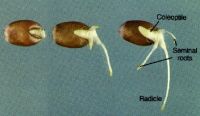
Planting and Germination |
Quality seed is essential for establishing a productive stand. Seed should have at least 85 percent germination and 56 pounds per bushel test weight and should not be shriveled. Large seeds have little, if any, advantage over normal, plump seeds when both are planted at equal volume or weight.
A wheat seed begins germination by absorbing water and oxygen. Adequate soil moisture and temperature are needed for this to occur. Two parts of the wheat seed are of greatest importance in germination: 1) the embryo that gives rise to the radicle (the seedling root) and the first leaf; 2) the endosperm which contains food in the form of starch and protein for germination and emergence. The coleoptile (second leaf), penetrates the soil and results in emergence of the seedling, usually within 5 to 7 days after planting. If the seed is planted too deep, beyond the elongation distance of the coleoptile, seedlings cannot emerge and a poor stand will occur. Semidwarf wheat varieties form short coleoptiles as well as short plants, and planting depth is particularly critical for them. A firm seedbed assures good contact between the seed and the soil. Inadequate soil moisture is probably the major reason for planting seed deeply. If the soil moisture runs out before the seedlings emerge then a poor stand can be expected. Seedlings from seeds that have germinated for only one or two days can survive desiccation and resume growth when moisture reoccurs, but seedlings that are 4 or 5 days old probably will not tolerate drying.
The first roots on the wheat seedling are known as primary or seminal roots and include the radicle previously mentioned. Primary roots are usually temporary in wheat, unless the other roots fail to develop because of poor conditions. Only the main stem of a wheat plant has primary roots, which may be retained throughout the life of the plant. Most of the root system throughout the life of a wheat plant consists of secondary or crown roots that arise from underground nodes after the seedling emerges. Many of the roots on the main stem and all the roots on the tillers are secondary roots. The functions of roots are to anchor the plant and absorb water and mineral nutrients. Most of the roots are in the top 6 inches of soil, but some penetrate as far as 7 feet into the soil. Water and minerals actually are absorbed through fine hairs on the roots’ surfaces. Extensive distribution of roots through the soil and the large surface area of the root hairs make the wheat plant efficient and drought-resistant.
|
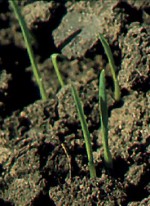
Feekes 1.0
Emergence
(one shoot formed) |
If desired, number of leaves present on the first shoot can be designated with a decimal. For example, 1.3 is a single shoot with three leaves unfolded. Without a doubt, the most significant event in achieving high yield of grain and/or forage in wheat is stand establishment. Planting high quality seed of an adapted wheat variety in a fertile, well prepared seedbed with enough moisture to achieve a rapid, uniform stand is a significant step in achieving acceptable yields.
Late planted wheat has less time to tiller and should be planted at a higher rate to compensate for fewer tillers. If early forage production is a goal, producers should increase seeding rates and depend less on tiller formation to produce early forage growth. |
Feekes 2.0
Beginning of tillering |
A tiller is a shoot which originates in the axil of a leaf or at the coleoptilar node. Tillers share the same root mass with the original shoot or main stem. Once established, secondary tillers may arise from the axils of the primary tillers; tertiary tillers may develop from the axils of secondary tillers, etc.
All above-ground growth on a wheat plant comes from a meristem termed the growing point. The growing
point contains the stem parts, nodes, internodes, and the wheat head in miniature. It is protected by its underground location until spring, when it "differentiates" and the plant begins to joint and eventually heads.
The third seedling leaf is the first foliage leaf. It and the other foliage leaves (as many as 11 to 15 in winter wheat) are the site of photosynthesis. Photosynthesis is the process in which small bodies called chloroplasts in cells of wheat leaves produce food and energy from sunlight, water, and carbon dioxide. All the foliage and grain produced by the wheat plant comes from photosynthesis.
Tillers are shoots that develop from nodal buds on older wheat shoots. The number of tillers is determined by
the seeding rate, soil moisture, fertility, temperature, and variety. A winter wheat plant grown under usual
conditions will have three to six tillers. Tillers develop soon after the seedling emerges from the soil and have all
the other growth stages of the main stem. Tillering can be encouraged by planting early; fertilizing with nitrogen; and applying water if soil moisture is low. Late planting is particularly disadvantageous because it reduces tillering and must be compensated by higher seeding rates. Tillers are formed only during the fall but make most of their growth in the following spring.
During tillering, the major management consideration is whether stands are adequate to achieve yield goals. Management inputs will not compensate for skippy or erratic stands caused by insects, poor seed quality, herbicide injury, etc. If stands are thin, but uniform, an early nitrogen (N) application may enhance the rate of tillering, potentially increasing the number of heads per square foot. Care must be taken with fall N application. If heat units are available, excess N applied at this time leads to a lush, vegetative growth which makes the crop more susceptible to winterkill, foliar fungal disease, and aphid injury. Adequate phosphorus (P) is strongly related to rooting and tiller development. If tiller development is a historic problem in a given field, close attention must be given to P soil test recommendations prior to planting. |
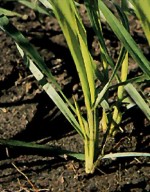
Feekes 3.0
Tillers formed |
Winter wheat can continue to tiller for several weeks. Depending upon planting date and weather conditions, tillering can either be interrupted by or completed prior to the onset of winter dormancy. Most of the tillers that contribute to grain yield potential are completed during this stage. Leaves begin to twist spirally. Many winter wheats are prostrate or "creeping" at stage 3.
Decreasing daylength and gradually falling temperatures during fall prompt the wheat plant to develop a high level of cold hardiness. Most varieties also undergo a change from an upright to a prostrate growth form. Hardiness usually is greatest during early winter and is lost gradually as the season progresses. Most winterkilling occurs during late winter, when warm spells cause the plants to loose hardiness and then are
followed by cold fronts that cause the damage. Snow provides excellent protection because it insulates the
plants from extreme cold and keeps them from responding to warm spells. The critical plant part is the
growing point, which is protected partially by being about 1 inch below the soil surface during winter. The
entire plant is killed by injury to the growing point, which turns from a white, turgid appearance to a brown,
wilted appearance after it is frozen. Leaves often stay green during mild winters, but freezing or "burning" of
leaves by cold has little effect on yield.
Major yield potential loss can occur from weed infestation during tiller formation, as weeds compete for light, water and nutrients. Once the wheat has achieved full canopy, little problem is experienced from weeds. Weed control decisions should be made before or during Feekes 3.0. The herbicide metribuzin may be applied for postemergence grass and broadleaf weed control during this growth stage on tolerant wheat varieties. In most cases, plants should have at least 4 tillers and be actively growing before application of this herbicide. The herbicide 2,4-D and similar phenoxy herbicides should not be applied until wheat is fully tillered, or after Feekes 3.0.
Growers should carefully scout for aphid and other insect infestations during Feekes 2.0 and 3.0, as stress from insect injury can reduce tiller formation. Control thresholds are much lower on small plants than later when plants are larger. |
Cotton
I want to thank Rick Minzenmayer, Stephen Biles, and Chris Sansone for their assistance in ginning cotton on November 27 at Lubbock. The fiber samples collected are currently being analyzed. The information will be sent to you as soon as it arrives. We were able to process 84 samples in two hours due to the effort made by all counties. The gin sample sizes between 600 and 700 grams processed quickly with very few problems. Thanks again for taking the time to weigh and prepare your samples.
The results obtained from harvest aid result demonstrations tests conducted this year ranged from good to poor. Glasscock County and Tom Green County (1, 2, 3, 4 and 5) test results are available in pdf format.
Weeds and Weed ID
Shown are weeds that are developing in cropland and barditiches at this time.
Pesticide Recertification Training
On Tuesday, December 4, there will be a CEU course conducted in Cross Plains. This is a five hour course and participants should call Robert Pritz to register for the meeting. His number is (915) 854-1518.
On Thursday, December 6, there will be a CEU course conducted in Brady. This is a five hour course and participants should call Jerry Kidd to register for the meeting. His number is (915) 597-1295.
On Monday December 10, there will be a training conducted at Abilene for producers needing to obtain a Private Applicators License. For more details and to register for the meeting call Gary Bomar at (915) 672-6048.
On December 13, a five hour CEU course will be held at the Abilene Civic Center. This training is being hosted by the City of Abilene, the Texas Cooperative Extension, and the Texas Department of Agriculture. For a copy of the agenda {click here}. To register for the meeting call Gary Bomar at (915) 672-6048.
Monthly Calendar
December
 December 3, District Office, Office Conference
December 3, District Office, Office Conference
 December 3, Tom Green County, Friends of Extension Luncheon
December 3, Tom Green County, Friends of Extension Luncheon
 December 4, Callahan County, CEU Course
December 4, Callahan County, CEU Course
 December 4 & 5, Brown County, TAEXSA Board Meeting
December 4 & 5, Brown County, TAEXSA Board Meeting
 December 6, McCulloch County, Multi-County CEU Meeting
December 6, McCulloch County, Multi-County CEU Meeting
 December 11, Bell County, CEA Training on Result Demonstrations
December 11, Bell County, CEA Training on Result Demonstrations
 December 13, Taylor County, CEU Course
December 13, Taylor County, CEU Course
 December 13, Mills County, Master Gardeners Program
December 13, Mills County, Master Gardeners Program
 December 21 - 31, Potter, Randall, & Deaf Smith Counties, Christmas Holiday
December 21 - 31, Potter, Randall, & Deaf Smith Counties, Christmas Holiday
January 2002
 January 7, District Office, Office Conference
January 7, District Office, Office Conference
 January 9 - 12, Atlanta Georgia, Beltwide Cotton Conference
January 9 - 12, Atlanta Georgia, Beltwide Cotton Conference
 January 15, San Saba County, Master Gardeners
January 15, San Saba County, Master Gardeners
 January 16, Brazos County, Committee Meeting
January 16, Brazos County, Committee Meeting
 January 18, Tom Green County, Professional Ag Workers
January 18, Tom Green County, Professional Ag Workers
 January 21, Dawson County, Southern Mesa Ag Conference
January 21, Dawson County, Southern Mesa Ag Conference
 January 23, Ector County, Master Gardeners
January 23, Ector County, Master Gardeners
 January 24, Howard County, Master Gardeners
January 24, Howard County, Master Gardeners
|
Sincerely,
Billy E. Warrick
Extension Agronomist
Texas Agricultural Extension Service
Texas A&M University System
|



 The cold temperatures that covered a large portion of District 7 (November 27-29) could prove damaging to the late planted wheat crop. Damage to wheat would have been worse if it weren't for the high soil moisture from rains received in early- and mid-November combined with snow. Snow is an excellent insulator and once it exceeds one inch of depth it provides the equivalent of about 10 degrees of protection. Wheat that is well tillered should be able to withstand temperatures in the -5 degree range for at least a short period of time. The longer it stays this cold the greater the risk of killing the growing point. If the top 2 inches of soil is wet, this will help insulate the wheat growing point. Expect to see significant leaf burn on most of our wheat.
The cold temperatures that covered a large portion of District 7 (November 27-29) could prove damaging to the late planted wheat crop. Damage to wheat would have been worse if it weren't for the high soil moisture from rains received in early- and mid-November combined with snow. Snow is an excellent insulator and once it exceeds one inch of depth it provides the equivalent of about 10 degrees of protection. Wheat that is well tillered should be able to withstand temperatures in the -5 degree range for at least a short period of time. The longer it stays this cold the greater the risk of killing the growing point. If the top 2 inches of soil is wet, this will help insulate the wheat growing point. Expect to see significant leaf burn on most of our wheat.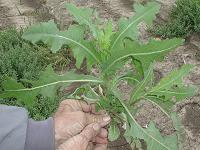
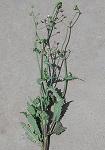
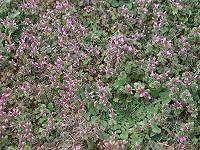
 December 3, District Office, Office Conference
December 3, District Office, Office Conference
 December 3, Tom Green County, Friends of Extension Luncheon
December 3, Tom Green County, Friends of Extension Luncheon
 December 4, Callahan County, CEU Course
December 4, Callahan County, CEU Course
 December 4 & 5, Brown County, TAEXSA Board Meeting
December 4 & 5, Brown County, TAEXSA Board Meeting
 December 6, McCulloch County, Multi-County CEU Meeting
December 6, McCulloch County, Multi-County CEU Meeting
 December 11, Bell County, CEA Training on Result Demonstrations
December 11, Bell County, CEA Training on Result Demonstrations
 December 13, Taylor County, CEU Course
December 13, Taylor County, CEU Course
 December 13, Mills County, Master Gardeners Program
December 13, Mills County, Master Gardeners Program
 December 21 - 31, Potter, Randall, & Deaf Smith Counties, Christmas Holiday
December 21 - 31, Potter, Randall, & Deaf Smith Counties, Christmas Holiday
 January 7, District Office, Office Conference
January 7, District Office, Office Conference
 January 9 - 12, Atlanta Georgia, Beltwide Cotton Conference
January 9 - 12, Atlanta Georgia, Beltwide Cotton Conference
 January 15, San Saba County, Master Gardeners
January 15, San Saba County, Master Gardeners
 January 16, Brazos County, Committee Meeting
January 16, Brazos County, Committee Meeting
 January 18, Tom Green County, Professional Ag Workers
January 18, Tom Green County, Professional Ag Workers
 January 21, Dawson County, Southern Mesa Ag Conference
January 21, Dawson County, Southern Mesa Ag Conference
 January 23, Ector County, Master Gardeners
January 23, Ector County, Master Gardeners
 January 24, Howard County, Master Gardeners
January 24, Howard County, Master Gardeners